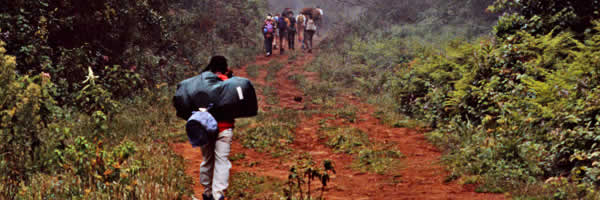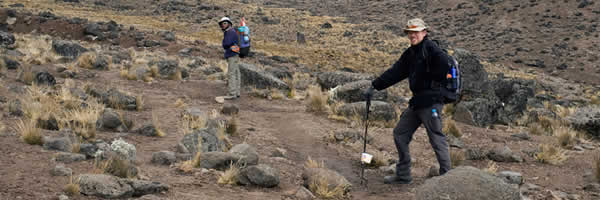Climbing Mount Kilimajaro Marangu Route, Climb Marangu Route to Uhuru Peak Summit (6 days)

Marangu Gate (1980m) - Mandara Hut (2700m)
The drive from Moshi to the Kilimanjaro National Park gate, takes about 50 minutes. The journey passes through Marangu, located on the lower slopes of the mountain. Once at the park gate, all hikers are requested to sign in at the Park office and make their final preparations for the climb. Porters are seen arranging and loading their packs, containing the food, water, cooking gas as well as most of your equipment. Make sure that you have all your daypack items (containing at least drinking water, your lunch pack and extra clothing) with you as the porters ascend a lot quicker than the hikers. Our guides will be available to assist with any additional information or needs you might have. Leave the Park gate and ascend on a cleared ridge trail through the rain forest, where most of Kilimanjaro's animals are found.
Your first night stop, Mandara hut, is a group of wooden A-framed huts in a forest clearing. Each hut features 6-8 sleeping bunks with solar generated lighting. The total capacity of the camp is 60 climbers. Water is piped into the camp from springs above and there are flush toilets behind the main hut.
Mandara hut (2700m) - Horombo Hut (3720m)
From Mandara hut the trail passes through a short stretch of forest, then skirts the base of the Maundi Crater and then emerges into the transition from rain forest to moorland. It is well worth a short detour to scramble up the rim of the Maundi Crater for your first really impressive view of the Kibo Crater. On a clear day, Kibo will glimmer in the distance, showing off her majestic glaciers in the morning sun. Once you are in the open moorland you will get the chance to see some of Kilimanjaro's most spectacular plants - the endemic giant lobelia which grows up to 3 m in height and the giant groundsel (Senecia Kilimanjari), which can reach heights of 5m! After about 6 hours from here you reach the Horombo hut, where you will have a day’s rest; an evening meal and overnight.
Horombo hut (3720m) - Acclimatisation Day
Horombo hut is a village of huts perched on a small plateau, with buildings similar to Mandara, but with a total capacity of 120 climbers! Horombo is normally bustling with hikers, guides and porters, with an atmosphere of adventure and excitement. You will meet both ascending and descending hikers here. This extra day and night at Horombo is for additional acclimatisation. A hike towards the Mawenzi hut, passing the Zebra Rocks on the way (about 3 hours up and 1,5 hours down), is strongly recommended. This hike will further assist with the process of acclimatisation. Remember to drink enough water and move slowly! All meals for the day are provided at the hut. Retire to bed early and get a last good night's rest.
Horombo hut (3720m) - Kibo hut (4700m)
After breakfast you now continue your ascent into the Alpine desert habitat. From Horombo there are two trails to the "Saddle" (which refers to the area located between the peaks of Mawenzi and Kibo). There is an upper route (right hand fork) and lower route (left hand fork) to choose from. The upper route (right hand fork) will be very familiar, as you will have climbed most of it the previous day towards Mawenzi hut. It is very stony and eroded. The recommended lower route (left hand fork) is much easier and nearly an hour shorter, and it also passes the last watering point at 4130m. You will have to fill your water bottles with all the water you will need until your return to Horombo hut in two night's time (unless you are willing to buy Mineral water at Kibo hut). Once again remember to slow down and drink enough water!!
Situated in the barren Alpine desert is Horombo hut, a stone build block house which has bunk beds for 60 climbers, but no streams with water nearby. It is however possible to buy mineral water and soft drinks at the camp office. The summit is now a further 1195m up and you will make your final ascent the same night. Prepare your equipment, ski-stick and thermal clothing for your summit bid. This should include the replacement of your headlamp and camera batteries and make sure you have a spare set available as well. To prevent freezing it will be wise to carry your water in a thermal flask.
(Summit Attempt) Kibo hut (4700m) - Uhuru Peak (5895m) - Horombo hut (3720m)
You will rise around 23h30, and after some tea and biscuits you shuffle off into the night. The first section of the trail consists of a rocky path to the Hans Meyer Cave (5150m), also a good resting spot. The path then zigzags up to Gillman's point (5,681m), which is located on the crater rim. This section is very steep with a lot of stone scree, requiring a great physical and mental effort. This is probably the most demanding section of the entire route. Move slowly.
From Gillmans Point you will normally encounter snow all the way up to Uhuru peak (5895m), the highest point in Africa. Total exhilaration and satisfaction - you made it. Weather conditions on the summit will determine how long you will be able to spend, taking photographs, before the 3 hour descent back to Kibo hut.
After a short rest you gather all your gear you left behind for the ascent and head down to Horombo hut (3 hours) for your overnight. The return to Horombo hut will seem surprisingly fast compared to the ascent. The total time spent walking on this day is around 14 hours, so be prepared for a very tough day. Later in the evening you enjoy your last dinner (with soft drinks and beer for sale at the camp office) on the mountain and a well-earned sleep, filled with memories and stirring emotions.
Horombo hut (3720m) - Marangu Gate (1980m)
After breakfast you continue your descent (6 hours), passing the Mandara hut, down to the Marangu gate. It is strongly recommended not to pay your porters any tips until you and all your gear have reached the gate safely. At Marangu gate you sign your name and details in a register. This is also where successful climbers receive their summit certificates. Those climbers who reached Gillman's Point (5685m) are issued with green certificates and those who reached Uhuru Peak (5895m), receive gold certificates. You now drive back to Moshi for a long overdue hot shower, dinner and celebrations!!
Clients on this route stay in Huts
NOTE:Extra night for acclimatisation is recommended at horombo hut.
The above Programme cost US $ 1700 per person

For more information and special offers, Please Inquire.
Trekking Cost Above Includes
- Arrival airport transfers
- Transport/Transfer to and from the mountain
- Meals as advised above for entire trek and tour
- Accommodation as detailed on the itinerary
- Tents and Mattress during your trek
- Services of a private mountain guide, cook and adequate porters to carry both trip provisions and client's private bags.
- National Park entrance, accommodation or camping fees.
- Food and catering equipment, breakfasts, lunches (packed when necessary) and evening meals prepared by our own cook.
- Special dietary requirements are catered for with prior arrangements at no extra cost.
- Certificate of Achievement/ appreciation from us.
- Free storage of excess baggage not required during mountain trekking.
- Crisis management apparatus VHF 2-way radio, basic first aid kit and an on call vehicle.
Trekking Cost Above Excludes:
- Travel and personal accident insurance.
- Visa, passport, vaccinations, medicines.
- Personal Mountain equipment.
- Tips.
- Expenditure on alcoholic drinks, souvenirs and other personal items.
- Optional excursions not detailed in the itinerary.
- Additional optional accommodation added at the base hotel or extra days on
- the mountain added.
- Treated drinking water
- Extra costs incurred in case of own intentional change of itinerary while
- already on trek.
- Porters to carry excess of 16Kg. personal luggage per client.
Trekking Personal Items:
- T-shirts (synthetic materials are best as cotton retains moisture)
- Waterproof thigh-length jacket (Goretex or similar)
- Gloves (waterproof warm outers + thin liners)
- Warm hat (or balaclava) that covers the ears
- Waterproof walking boots (well broken-in)
- Waterproof outer trousers _ Warm mid-layer (fleece or down)
- Warm long-sleeved shirt _ Warm walking trousers (not jeans!)
- Thermal underwear _ Walking socks (several pairs)
- Walking shorts
- Trainers or soft shoes for relaxing
- Sun-hat
- Gaiters
Equipment:
- Glacier glasses (or good quality sunglasses ? preferably with side shields)
- Personal first aid kit essential medication
- Wet wipes
- Warm sleeping bag (3/4-season)
- Sleeping bag liner
- Trekking pole(s) - can be hired locally
- Small towel
- Headtorch spare batteries
- Spare plastic bags
- Waterbottle(s) - minimum 3 litres capacity
- High factor sunscreen lipsalve
- High energy snacks, dried fruit, nuts, sweets, etc. NB: hang on to some till the last day - you?ll appreciate them more!
- A small bottle of cordial or squash concentrate (to liven up the ?flat? taste of boiled water)
Contact Us
MARANGU LUXURY SHUTTLES
Windsor House 4th Floor.
University way / Muindi Mbingu street Junction
P. O. Box 24105 - 00100
Nairobi, KENYA.
Office Phone : +254 203 555 780
Hotline 1 : +254 722 165 331
Hotline 2 : +254 722 124 349
Hotline 3 : +254 733 918 166
Email: [email protected]
Gmail: [email protected]
Website: www.marangushuttles.com